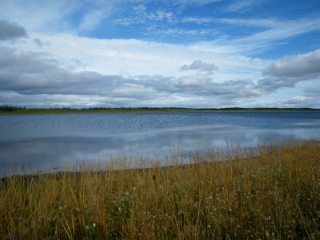New permafrost is forming around shrinking Arctic lakes

Researchers from McGill and the U.S. Geological Survey, more used to measuring thawing permafrost than its expansion, have made a surprising discovery.
There is new permafrost forming around Twelvemile Lake in the interior of Alaska. But they have also quickly concluded that, given the current rate of climate change, it won’t last beyond the end of this century.
Twelvemile Lake is sometimes called the disappearing lake. That’s because over the past thirty years, as a result of climate change and thawing permafrost, the lake water has been receding at an alarming rate.
It is now 5 metres or 15 feet shallower than it would have been three decades ago. This is a big change in a very short time.
As the lake recedes, bands of willow shrubs have grown up on the newly exposed lake shores over the past twenty years. What Martin Briggs from the U.S. Geological Survey and Prof. Jeffrey McKenzie from McGill’s Dept. of Earth and Planetary Science have just discovered is that the extra shade provided by these willow shrubs has both cooled and dried the surrounding soil, allowing new permafrost to expand beneath them.
The researchers were initially very excited by this find. But after analyzing the thickness of the new permafrost and projecting how it will be affected by continued climate change and the expected rise in temperature in the Arctic of 3°C, they arrived at the conclusion that the new permafrost won’t last beyond the end of the century.
To read “New permafrost is forming around shrinking Arctic lakes, but will it last?” by Martin Briggs et al in Geophysical Research Letters: http://onlinelibrary.wiley.com/enhanced/doi/10.1002/2014GL059251/
More photos
Contact Information
Media Contact
All latest news from the category: Earth Sciences
Earth Sciences (also referred to as Geosciences), which deals with basic issues surrounding our planet, plays a vital role in the area of energy and raw materials supply.
Earth Sciences comprises subjects such as geology, geography, geological informatics, paleontology, mineralogy, petrography, crystallography, geophysics, geodesy, glaciology, cartography, photogrammetry, meteorology and seismology, early-warning systems, earthquake research and polar research.
Newest articles

Superradiant atoms could push the boundaries of how precisely time can be measured
Superradiant atoms can help us measure time more precisely than ever. In a new study, researchers from the University of Copenhagen present a new method for measuring the time interval,…

Ion thermoelectric conversion devices for near room temperature
The electrode sheet of the thermoelectric device consists of ionic hydrogel, which is sandwiched between the electrodes to form, and the Prussian blue on the electrode undergoes a redox reaction…

Zap Energy achieves 37-million-degree temperatures in a compact device
New publication reports record electron temperatures for a small-scale, sheared-flow-stabilized Z-pinch fusion device. In the nine decades since humans first produced fusion reactions, only a few fusion technologies have demonstrated…





















